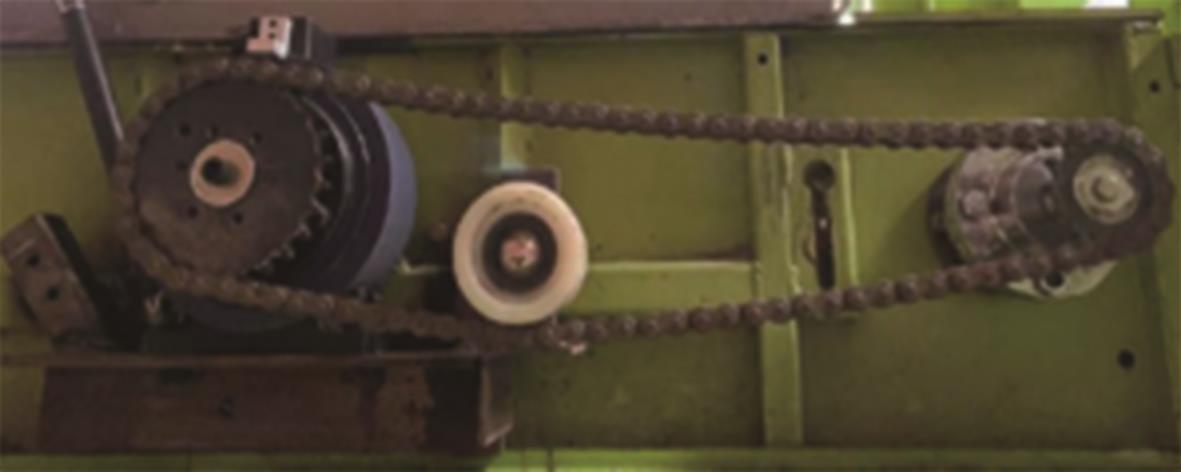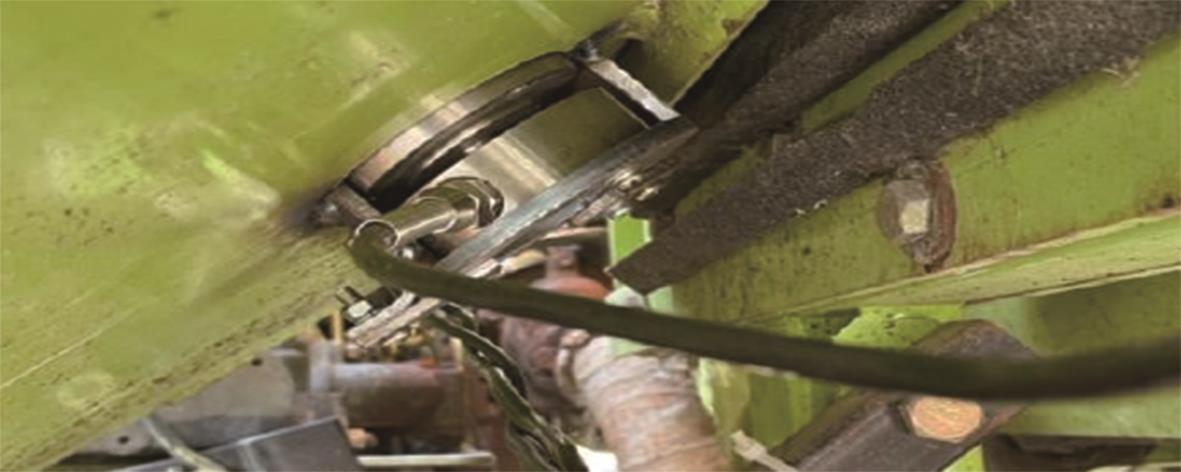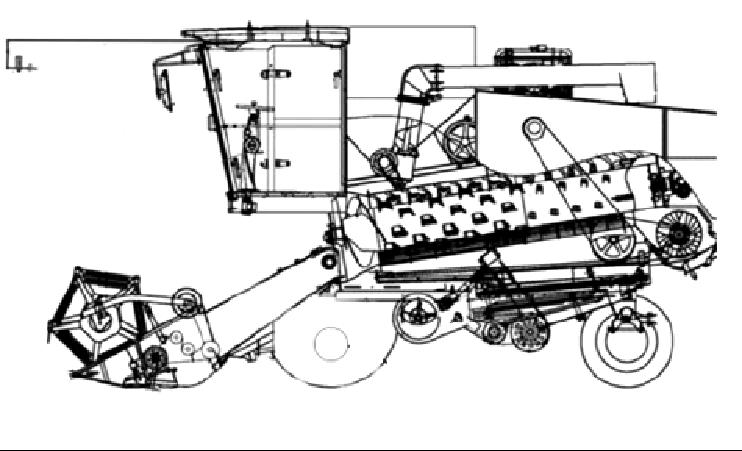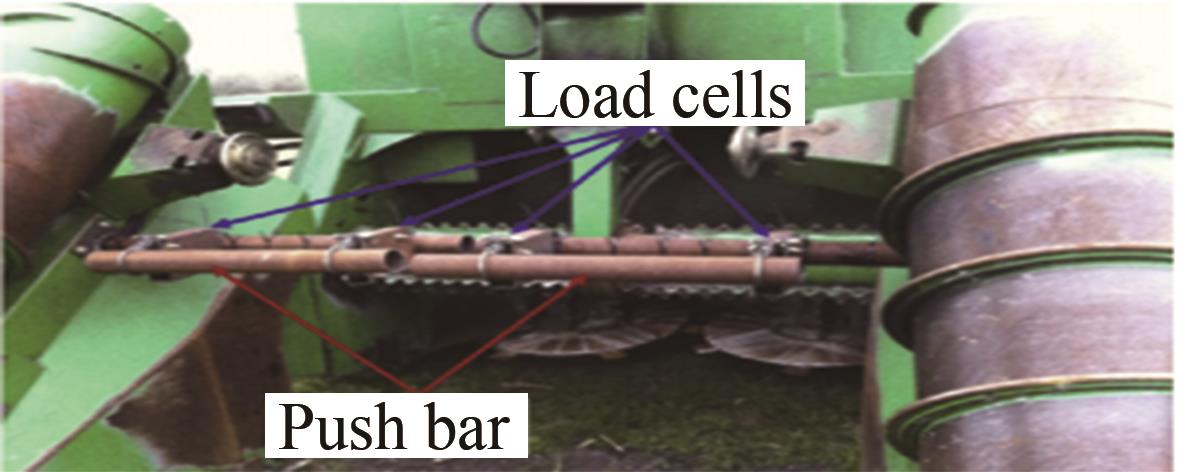Journal of Intelligent Agricultural Mechanization ›› 2025, Vol. 6 ›› Issue (1): 71-80.DOI: 10.12398/j.issn.2096-7217.2025.01.007
Previous Articles Next Articles
CHEN Xu1,2( ), HE Xun1,2, ZHU Chenhui1,2, WANG Baoshan1,2, WANG Wanzhang1,2(
), HE Xun1,2, ZHU Chenhui1,2, WANG Baoshan1,2, WANG Wanzhang1,2( )
)
Received:2024-03-04
Revised:2024-04-11
Online:2025-02-15
Published:2025-02-15
Corresponding author:
WANG Wanzhang
About author:CHEN Xu, E-mail: chenxu1994@stu.henau.edu.cn
Supported by:CLC Number:
CHEN Xu, HE Xun, ZHU Chenhui, WANG Baoshan, WANG Wanzhang. Research status and development trend of feed quantity detection technology for grain combine harvester[J]. Journal of Intelligent Agricultural Mechanization, 2025, 6(1): 71-80.
Add to citation manager EndNote|Ris|BibTeX
URL: http://znhnyzbxb.niam.com.cn/EN/10.12398/j.issn.2096-7217.2025.01.007
| 检测位置 | 检测装置 | 装置安装结构示意图 | 主要特点 |
|---|---|---|---|
| 割台主动轴 | 扭矩传感器 |  | 具有较好的实时性,但安装不便 |
| 脱粒滚筒轴 | 扭矩传感器 |  | 由于空间小,难以应用安装在联合收获机上,且实时性较差 |
| 倾斜输送器底板出口 | 压力传感器 |  | 在理想环境下精度较高,但未解决倾斜输送器角度随作业地块状况和割茬高度不断变化造成误差的问题 |
| 机前 | 工业相机 |  | 安装便捷,但由于机器震动和田间收获扬尘较大,获取的图片模糊,对后期图像处理预测喂入量偏差影响较大 |
| 割台 | 力传感器 |  | 安装方便,能够实现作物未进入机器前对喂入量的预测,但受作物品种、生长环境的影响较大 |
Table 1 Typical feeding quantity detection methods
| 检测位置 | 检测装置 | 装置安装结构示意图 | 主要特点 |
|---|---|---|---|
| 割台主动轴 | 扭矩传感器 |  | 具有较好的实时性,但安装不便 |
| 脱粒滚筒轴 | 扭矩传感器 |  | 由于空间小,难以应用安装在联合收获机上,且实时性较差 |
| 倾斜输送器底板出口 | 压力传感器 |  | 在理想环境下精度较高,但未解决倾斜输送器角度随作业地块状况和割茬高度不断变化造成误差的问题 |
| 机前 | 工业相机 |  | 安装便捷,但由于机器震动和田间收获扬尘较大,获取的图片模糊,对后期图像处理预测喂入量偏差影响较大 |
| 割台 | 力传感器 |  | 安装方便,能够实现作物未进入机器前对喂入量的预测,但受作物品种、生长环境的影响较大 |
| 喂入量/(kg·s-1) | 割台主动轴扭矩电压/V | 倾斜输送器扭矩电压/V | 螺旋输送器功率/kW | 纵轴流滚筒扭矩 /(N·m) |
|---|---|---|---|---|
| 0.5 | 0.2 | 0 | 0.425 | 25.68 |
| 1 | 1.41 | 0.5 | 0.475 | 43.16 |
| 1.5 | 2.88 | 1.12 | 0.525 | 60.64 |
| 2 | 4.35 | 1.74 | 0.575 | 78.13 |
Table 2 Relationship between feeding amount, torque and power
| 喂入量/(kg·s-1) | 割台主动轴扭矩电压/V | 倾斜输送器扭矩电压/V | 螺旋输送器功率/kW | 纵轴流滚筒扭矩 /(N·m) |
|---|---|---|---|---|
| 0.5 | 0.2 | 0 | 0.425 | 25.68 |
| 1 | 1.41 | 0.5 | 0.475 | 43.16 |
| 1.5 | 2.88 | 1.12 | 0.525 | 60.64 |
| 2 | 4.35 | 1.74 | 0.575 | 78.13 |
| 参数 | 与喂入量的相关系数 | 检测误差 |
|---|---|---|
| 螺旋搅龙功率 | 0.91 | / |
| 割台传动轴扭矩 | 0.852 | ≤30% |
| 倾斜输送器动力轴扭矩 | 0.783 | 16.1% |
| 脱粒滚筒轴扭矩 | 0.912 | ≤5% |
Table 3 Correlation between various parameters and feeding amount
| 参数 | 与喂入量的相关系数 | 检测误差 |
|---|---|---|
| 螺旋搅龙功率 | 0.91 | / |
| 割台传动轴扭矩 | 0.852 | ≤30% |
| 倾斜输送器动力轴扭矩 | 0.783 | 16.1% |
| 脱粒滚筒轴扭矩 | 0.912 | ≤5% |
| 类型 | 优点 | 缺点 |
|---|---|---|
| 主动轴扭矩或功率 | 采集的信号稳定、精度较高 | 扭矩传感器不便于安装 |
| 物料挤压力 | 检测装置成本低廉 | 受物料输送的不均匀性影响较大 |
| 机器视觉和激光雷达 | 便于安装在机器前方进行作物信息采集 | 成本较高,受恶劣环境影响较大 |
| 作物茎秆弯曲力 | 可以在物料未进入机器前对喂入量进行预测 | 预测结果受作物品种影响较大 |
Table 4 Characteristics of four feeding quantity detection methods
| 类型 | 优点 | 缺点 |
|---|---|---|
| 主动轴扭矩或功率 | 采集的信号稳定、精度较高 | 扭矩传感器不便于安装 |
| 物料挤压力 | 检测装置成本低廉 | 受物料输送的不均匀性影响较大 |
| 机器视觉和激光雷达 | 便于安装在机器前方进行作物信息采集 | 成本较高,受恶劣环境影响较大 |
| 作物茎秆弯曲力 | 可以在物料未进入机器前对喂入量进行预测 | 预测结果受作物品种影响较大 |
| 1 | 卢里耶, 格罗姆勃切夫斯基 著. 农业机械的设计和计算[M]. 北京: 中国农业机械出版社, 1983. |
| 2 | 陈度, 王书茂, 康峰, 等. 联合收割机喂入量与收获过程损失模型[J]. 农业工程学报, 2011, 27(9): 18-21. |
| CHEN Du, WANG Shumao, KANG Feng, et al. Mathematical model of feeding rate and processing loss for combine harvester [J]. Transactions of the Chinese Society of Agricultural Engineering, 2011, 27(9): 18-21. | |
| 3 | 管延华. 浅析谷物联合收获机的喂入量[J]. 中国农机化, 2012(5): 51-53. |
| GUAN Yanhua. Brief analysis on feeding amount of grain combine harvester [J]. Chinese Agricultural Mechanization, 2012(5): 51-53. | |
| 4 | LIANG Z, QIN Y, SU Z. Establishment of a feeding rate prediction model for combine harvesters [J].Agriculture, 2024, 14(4): 589. |
| 5 | 冉军辉, 吴崇友. 传感器在谷物联合收获机中的应用进展及发展方向[J]. 江苏农业科学, 2019, 47(22): 23-29. |
| 6 | 何勋, 陈旭, 屈哲, 等. 小麦收获智能化技术应用研究进展[J]. 河南农业大学学报, 2022, 56(3): 341-354. |
| HE Xun, CHEN Xu, QU Zhe, et al. Review on application research and development of intelligent technology in the process of wheat harvest [J]. Journal of Henan Agricultural University, 2022, 56(3): 341-354. | |
| 7 | CHEN X, HE X, WANG W, et al. Study on the technologies of loss reduction in wheat mechanization harvesting: A review [J]. Agriculture, 2022, 12(11): 1935. |
| 8 | 倪俊旗. 小麦机收清选损失探索与研究[J]. 农业机械, 2021(5): 91-93. |
| 9 | JIM K. Computer control for the combine [J]. Agricultural Engineering, 1983, 64(2): 7-9. |
| 10 | 曹崇文. 谷物联合收割机的自动调节[J]. 粮油加工与食品机械, 1975(A2): 75-90, 97. |
| 11 | 汤玲玉, 魏新华, 童浩, 等. 联合收割机喂入量检测方法研究[J]. 农机化研究, 2023, 45(5): 37-42. |
| TANG Lingyu, WEI Xinhua, TONG Hao, et al. Research on the detection method of combine harvester feeding rate [J]. Journal of Agricultural Mechanization Research, 2023, 45(5): 37-42. | |
| 12 | 介战, 周学健. 喂入量传感器测试模型研究[J]. 农业机械学报, 2001(5): 53-55. |
| Zhan JIE, ZHOU Xuejian. Study on mathematical model of feed quantity sensors measuring [J]. Transactions of the Chinese Society for Agricultural Machinery, 2001(5): 53-55. | |
| 13 | 罗四倍, 介战. 无线数据采集和虚拟仪器在喂入量测量中的应用[J]. 河南科技大学学报(自然科学版), 2010, 31(5): 72-75, 111-112. |
| LUO Sibei, Zhan JIE. Application of wireless data acquisition and virtual instrument techniques to measurement of combine feed quantity [J]. Journal of Henan University of Science and Technology (Natural Science), 2010, 31(5): 72-75, 111-112. | |
| 14 | 张姝琦. 基于机器视觉的油菜收获喂入量及品质监测[D]. 南京: 南京大学, 2021. |
| ZHANG Shuqi. Monitoring the feeding quantity and quality of rape harvest based on machine vision [D]. Nanjing: Nanjing University, 2021. | |
| 15 | MATHANKER S K, MAUGHAN J D, HANSEN A C, et al. Sensing miscanthus swath volume for maximizing baler throughput rate [J]. Transactions of the ASABE, 2014, 57(2): 355-362. |
| 16 | SAEYS W, LENAERTS B, CRAESSAERTS G, et al. Estimation of the crop density of small grains using LiDAR sensors [J]. Biosystems Engineering, 2009, 102(1): 22-30. |
| 17 | MATHANKER S K, BUSS J C, GAN H, et al. Stem bending force and hydraulic system pressure sensing for predicting napiergrass yield during harvesting [J]. Computers and Electronics in Agriculture, 2015, 111: 174-178. |
| 18 | FRIESEN O H, ZOERB G C, BIGSBY F W. For combines: controlling feedrates automatically [J]. Agricultural Engineering, 1966, 47(8): 434-435. |
| 19 | EIMER M. Automatic control of combine threshing process [C]// IFAC Symposium on Automatic Control for Agriculture. 1974. |
| 20 | 刘元元, 刘卉, 尹彦鑫, 等. 基于功率监测的联合收割机喂入量预测方法[J]. 中国农业大学学报, 2017, 22(11): 157-163. |
| LIU Yuanyuan, LIU Hui, YIN Yanxin, et al. Feeding assessment method for combine harvester based on power measurement [J]. Journal of China Agricultural University, 2017, 22(11): 157-163. | |
| 21 | 张振乾, 孙意凡, 刘仁杰, 等. 联合收获机喂入量监测系统设计与试验[J]. 农业机械学报, 2019, 50(6): 85-92. |
| ZHANG Zhenqian, SUN Yifan, LIU Renjie, et al. Design and test of feed rate monitoring system for combine harvester [J]. Transactions of the Chinese Society for Agricultural Machinery, 2019, 50(6): 85-92. | |
| 22 | SUN Y, LIU R, ZHANG M, et al. Design of feed rate monitoring system and estimation method for yield distribution information on combine harvester [J]. Computers and Electronics in Agriculture, 2022, 201: 107322. |
| 23 | 孙意凡, 刘仁杰, 欧颢, 等. 基于功率测量的联合收获机喂入量检测方法研究[J].农业机械学报, 2020, 51(5): 118-123. |
| SUN Yifan, LIU Renjie, Hao OU, et al. Analysis and comparison of feed rate detection methods of combine harvester based on power detection [J]. Transactions of the Chinese Society for Agricultural Machinery, 2020, 51(5): 118-123. | |
| 24 | 梁学修, 陈志, 张小超, 等. 联合收获机喂入量在线监测系统设计与试验[J]. 农业机械学报, 2013, 44(S2): 1-6. |
| LIANG Xuexiu, CHEN Zhi, ZHANG Xiaochao, et al. Design and experiment of on-line monitoring system for feed quantity of combine harvester [J]. Transactions of the Chinese Society for Agricultural Machinery, 2013, 44(S2): 1-6. | |
| 25 | 陈进, 李耀明, 季彬彬. 联合收获机喂入量测量方法[J]. 农业机械学报, 2006(12): 76-78. |
| CHEN Jin, LI Yaoming, JI Binbin. Study on measurement method of combine feed quantity [J]. Transactions of the Chinese Society for Agricultural Machinery, 2006(12): 76-78. | |
| 26 | 介战, 朱永宁, 李振华, 等. 谷物随机喂入量定量测试技术研究[J]. 洛阳工学院学报, 1990, 11(3): 43-48. |
| Zhan JIE, ZHU Yongning, LI Zhenhua, et al. Study on quantitative measuring technique for random feed quantity of grain [J]. Journal of Luoyang Institute of Technology, 1990, 11(3): 43-48. | |
| 27 | 介战, 朱永宁, 李建朝, 等. 谷物联合收割机喂入量测试装置[J]. 粮油加工与食品机械, 1994(6): 12-14. |
| Zhan JIE, ZHU Yongning, LI Jianchao, et al. Test device for feeding amount of grain combine harvesters [J]. Cereals and Oils Processing(Electronic Version), 1994 (6): 12-14. | |
| 28 | 赵胜华, 张国忠, 张仕杰, 等. 基于薄膜传感器的横轴流脱粒滚筒实时喂入量测量系统设计[J]. 华中农业大学学报, 2020, 39(2): 160-169. |
| ZHAO Shenghua, ZHANG Guozhong, ZHANG Shijie, et al. Designing a real-time feed measurement system for horizontal axial flow threshing drum based on thin film sensor [J]. Journal of Huazhong Agricultural University, 2020, 39(2): 160-169. | |
| 29 | 王万章, 袁玲合, 兰明明, 等. 一种谷物联合收获机喂入量检测方法[P]. 河南省: CN202211630680.6, 2023-03-14. |
| 30 | 刘婉茹. 小麦植株建模与单纵轴流小麦联合收获机物料输送检测试验[D]. 郑州: 河南农业大学, 2022. |
| LIU Wanru. Establishment wheat plant model and test of material movement of single longitudinal axial flow wheat combine harvester [D]. Zhengzhou: Henan Agricultural University, 2022. | |
| 31 | 杨涛, 李晓晓. 机器视觉技术在现代农业生产中的研究进展[J]. 中国农机化学报, 2021, 42(3): 171-181. |
| YANG Tao, LI Xiaoxiao. Research progress of machine vision technology in modern agricultural production [J]. Journal of Chinese Agricultural Mechanization, 2021, 42(3): 171-181. | |
| 32 | 秦昌友, 杨艳山, 顾峰玮, 等. 现代农业领域中计算机视觉技术的运用与发展[J]. 中国农机化学报, 2023, 44(12): 119-128. |
| QIN Changyou, YANG Yanshan, GU Fengwei, et al. Application and development of computer vision technology in modern agriculture [J]. Journal of Chinese Agricultural Mechanization, 2023, 44(12): 119-128. | |
| 33 | 田鹏菲, 王皞阳. 机器视觉技术在我国农业领域内的应用分析[J]. 江苏农业科学, 2023, 51(14): 13-21. |
| TIAN Pengfei, WANG Haoyang. Application analysis of machine vision technology in Chinese agricultural fields [J]. Jiangsu Agricultural Sciences, 2023, 51(14): 13-21. | |
| 34 | 徐辉煌, 吴敏, 王梦露. 基于图像处理的菊花收缩率及色泽变化研究[J]. 智能化农业装备学报(中英文), 2024, 5(4): 24-38. |
| XU Huihuang, WU Min, WANG Menglu. Study on the kinetics of shrinkage and color changes of chrysanthemum based on image processing [J]. Journal of Intelligent Agricultural Mechanization, 2024, 5(4): 24-38. | |
| 35 | SAEYS W, LENAERTS B, CRAESSAERTS G, et al. Estimation of the crop density of small grains using LiDAR sensors [J]. Biosystems Engineering, 2009, 102(1): 22-30. |
| 36 | 陈进, 王志文, 陈海文, 等. 一种联合收获机喂入量在线预测装置及方法[P]. 江苏省: CN202011008723.8, 2021-01-19. |
| 37 | 潘静, 邵陆寿, 王轲. 水稻联合收割机喂入密度检测方法[J]. 农业工程学报, 2010, 26(8): 113-116. |
| PAN Jing, SHAO Lushou, WANG Ke. Detection method on feed density for rice combine [J]. Transactions of the Chinese Society of Agricultural Engineering, 2010, 26(8): 113-116. | |
| 38 | 郑玲. 小麦生物量田间快速测量方法研究[D]. 杨凌: 西北农林科技大学, 2016. |
| ZHENG Ling. Research on the fast detection method of wheat biomass in field [D]. Yangling:Northwest A&F University, 2016. | |
| 39 | 郭维俊, 黄高宝, 王芬娥. 作物生长力学的研究进展[J]. 甘肃农业大学学报, 2005(4): 555-559. |
| GUO Weijun, HUANG Gaobao, WANG Fen'e. Research progress on mechanics of crop growth [J]. Journal of Gansu Agricultural University, 2005(4): 555-559. | |
| 40 | 朱艳姝, 朱大洲, 朱石沙, 等. 小麦茎秆机械强度的力学评价研究[J]. 农机化研究, 2012, 34(9): 17-23. |
| ZHU Yanshu, ZHU Dazhou, ZHU Shisha, et al. Study on the mechanical evaluation model of mechanical strength of wheat stalks [J]. Journal of Agricultural Mechanization Research, 2012, 34 (9): 17-23. | |
| 41 | 刘庆庭, 区颖刚, 卿上乐, 等. 农作物茎秆的力学特性研究进展[J]. 农业机械学报, 2007(7): 172-176. |
| LIU Qingting, QU Yinggang, QING Shangle, et al. Study progress on mechanics properties of crop stalks [J]. Transactions of the Chinese Society for Agricultural Machinery, 2007(7): 172-176. | |
| 42 | 郭翠花, 高志强, 苗果园. 不同产量水平下小麦倒伏与茎秆力学特性的关系[J]. 农业工程学报, 2010, 26(3): 151-155. |
| GUO Cuihua, GAO Zhiqiang, MIAO Guoyuan. Relationship between lodging and mechanical characteristics of winter wheat stem under different yield levels [J]. Journal of Agricultural Engineering, 2010, 26(3): 151-155. | |
| 43 | MATHANKER S K, HANSEN A C, GRIFT T E, et al. Sensing miscanthus stem bending force for maximizing throughput rate in a disk mower-conditioner [J]. Transactions of the ASABE, 2014, 57(1): 5-12. |
| 44 | 郑玲, 朱大洲, 王成, 等. 基于LabVIEW的小麦生物量检测系统[J]. 农业机械学报, 2013, 44(9): 214-218. |
| ZHENG Ling, ZHU Dazhou, WANG Cheng, et al. Detection system for wheat biomass based on LabVIEW [J]. Transactions of the Chinese Society for Agricultural Machinery, 2013, 44(9): 214-218. | |
| 45 | 高志朋, 徐立章, 李耀明, 等. 履带式稻麦联合收获机田间收获工况下振动测试与分析[J]. 农业工程学报, 2017, 33(20): 48-55. |
| GAO Zhipeng, XU Lizhang, LI Yaoming, et al. Vibration measure and analysis of crawler-type rice and wheat combine harvester in field harvesting condition [J]. Transactions of the Chinese Society of Agricultural Engineering, 2017, 33(20): 48-55. | |
| 46 | 解鸿儒, 金诚谦, 印祥, 等. 履带式大豆联合收获机振动测试与分析[J]. 农机化研究, 2019, 41(8): 158-163, 174. |
| XIE Hongru, JIN Chengqian, YIN Xiang, et al. Vibration measurement and analysis of tracked soybean combine harvester [J]. Journal of Agricultural Mechanization Research, 2019, 41 (8): 158-163, 174. | |
| 47 | 刘仲鹏, 赵建军, 刘丽娟. 基于改进算法的小麦收获机作物密度检测研究[J]. 农机化研究, 2015, 37(8): 49-52. |
| LIU Zhongpeng, ZHAO Jianjun, LIU Lijuan. Study on wheat harvester crop density detection during maturity based on the improved algorithms [J]. Journal of Agricultural Mechanization Research, 2015, 37(8): 49-52. | |
| 48 | 张振乾, 彭程, 孙意凡, 等. 联合收获机喂入量监测系统信号分析与处理[J]. 农业机械学报, 2019, 50(S1): 73-78. |
| ZHANG Zhenqian, PENG Cheng, SUN Yifan, et al. Signal analysis and processing of combine harvester feedrate monitoring system [J]. Transactions of the Chinese Society for Agricultural Machinery, 2019, 50(S1): 73-78. | |
| 49 | 传感器,未来可期[J]. 自动化博览, 2016(5): 28-29. |
| 50 | 何万龄. 传感器及其应用分析[J]. 中学生数理化(高二版), 2009(12): 37-38. |
| 51 | 吴琼, 王秀均, 潘放. 传感器在联合收割机上的应用[J]. 现代化农业, 1996(2): 29-30. |
| 52 | 吴清分. 国外联合收割机的最新发展趋势[J]. 拖拉机与农用运输车, 2019, 46(4): 1-4, 10. |
| WU Qingfen. Latest development trend of foreign combine harvesters [J]. Tractor & Farm Transporter, 2019, 46(4): 1-4, 10. | |
| 53 | SÜMER S K, SAY S M, EGE F, et al. Noise exposed of the operators of combine harvesters with and without a cab [J]. Applied Ergonomics, 2006, 37(6): 749-756. |
| 54 | 中国农业机械化科学研究院. 国内外收获机械化技术发展趋势[J]. 农机科技推广, 2003(5): 4-5. |
| 55 | ARNER J R.Combine harvester rotor load control [P]. US: 19980022112, 2000-03-14. |
| 56 | 林伟, 吕新民, 樊建荣. 基于喂入量的联合收割机速度控制系统的研究[J]. 农机化研究, 2009, 31(5): 118-121. |
| LIN Wei, Xinmin LÜ, FAN Jianrong. Research on combine harvesters' velocity control system based on feed quantity [J]. Journal of Agricultural Mechanization Research, 2009, 31(5): 118-121. | |
| 57 | 介战, 貌建华, 万庆, 等. 联合收割机喂入量自适应控制液压系统[J]. 中国农机化, 2002(1): 38-39. |
| Zhan JIE, MAO Jianhua, WAN Qing, et al. Hydraulic system for adaptive control of feed rate in combine harvesters [J]. Journal of Chinese Agricultural Mechanization, 2002(1): 38-39. | |
| 58 | 王志文. 基于喂入量预测的联合收获机作业速度控制系统研究[D]. 镇江: 江苏大学, 2021. |
| WANG Zhiwen. Research on speed control system of combine harvester based on feed quantity forecast [D]. Zhenjiang: Jiangsu University, 2021. |
| [1] | CAI Jiayi, LIU Shiwei, SHAN Longxiang, LIU Yong, SHEN Hongyi, WANG Qiaohua. Design and experiment of cracked egg sorting robot based on machine vision and YOLO v5 [J]. Journal of Intelligent Agricultural Mechanization, 2025, 6(1): 41-50. |
| [2] | YANG Ke, LI Ju, CHEN Yu, LI Hao, AO Yu, LEI Xiaolong. Design and testing of a liftable chassis for rice harvester [J]. Journal of Intelligent Agricultural Mechanization, 2025, 6(1): 59-70. |
| [3] | SUN Zhu, GU Wei, CUI Longfei, CAI Chen, CHEN Chen, ZHOU Qingqing, DING Suming, LAN Yubin, XUE Xinyu. Research status and development trends of key technologies for intelligent plant protection equipment [J]. Journal of Intelligent Agricultural Mechanization, 2024, 5(4): 1-23. |
| [4] | WANG Yuanhong, YANG Zhiming, WANG Qi, LU Jinzhu, GAO Junfeng. Design and experiment of tea bud recognition method and light source of recognition system based on YOLOv5-SPD [J]. Journal of Intelligent Agricultural Mechanization, 2024, 5(3): 33-43. |
| [5] | ZHANG Ruizhi, LIU Qianyuan, HUANG Yuying, LIU Bing, CHANG Zhiguang, WANG Jiaoling. Development status and prospect of cold chain logistics of fruits, vegetables, and agricultural products based on intelligent technology [J]. Journal of Intelligent Agricultural Mechanization, 2024, 5(3): 63-74. |
| [6] | AN Jing, ZHANG Keping, LI Xiaokang, YANG Zhikai. Design and test of automatic net-wrapping mechanism for small round baler in hilly and mountainous areas [J]. Journal of Intelligent Agricultural Mechanization, 2024, 5(2): 61-69. |
| [7] | LEI Xiaolong, CHEN Yu, LI Ju, YANG Ke, LIU Cheng, YU Xiangyang. Design and experiment of chassis automatic lifting hydraulic system for harvester [J]. Journal of Intelligent Agricultural Mechanization, 2024, 5(2): 9-18. |
| [8] | QIAN Zhenjie, JIN Chengqian, LIU Zheng, YANG Tengxiang. Development status and trends of intelligent control technology in unmanned farms [J]. Journal of Intelligent Agricultural Mechanization, 2023, 4(3): 1-13. |
| [9] | CUI Xinyu, CUI Bingbo, MA Zhen, HAN Yi, ZHANG Jianxin, WEI Xinhua. Integration of geometric-based path tracking controller and its application in agricultural machinery automatic navigation [J]. Journal of Intelligent Agricultural Mechanization, 2023, 4(3): 24-31. |
| [10] | BAI Zhenwei, YAN Fuwei, YUAN Peihai, ZHANG Haoming, YANG Runshu. Design and experiment of fruit sorting robot based on embedded machine vision [J]. Journal of Intelligent Agricultural Mechanization, 2023, 4(3): 61-70. |
| [11] | YANG Liang, WANG Hui, CHEN Ruipeng, SHENG Qingkai, YUAN Zhen, XIONG Benhai. Advances in pig-specific sensors [J]. Journal of Intelligent Agricultural Mechanization, 2023, 4(2): 22-34. |
| [12] | LI Qianxi, SUN Xiaoming, JIANG Hanhui, WU Airu, FU Longsheng, LI Rui. Design and test of intelligent spraying unmanned vehicle for greenhouse tomato based on YOLOv4-tiny [J]. Journal of Intelligent Agricultural Mechanization, 2023, 4(2): 44-52. |
| [13] | CHENG Zhen, SONG Jingling, XU Hongcen, ZHANG Mingliang. Overview of intelligent orientation technology of garlic seed based on machine vision [J]. Journal of Intelligent Agricultural Mechanization, 2023, 4(2): 63-70. |
| [14] | Bai Xuefeng, Chang Jiangxue, Teng Zhaoli, Lu Zhixiong. Research progress on key technologies of intelligent agricultural tractors in China [J]. Journal of Intelligent Agricultural Mechanization (in Chinese and English), 2022, 3(2): 10-21. |
| [15] | Wang Zhuoxuan, Wang Lihui, Xu Ninghui, Li Yong, Shi Jiachen. Research on the control strategy of sideslip and hysteresis of intelligent harvesting robot [J]. Journal of Intelligent Agricultural Mechanization (in Chinese and English), 2022, 3(2): 37-44. |
| Viewed | ||||||
|
Full text |
|
|||||
|
Abstract |
|
|||||
